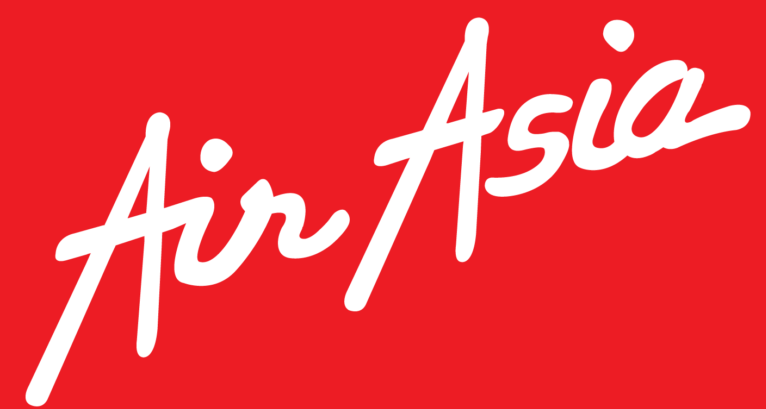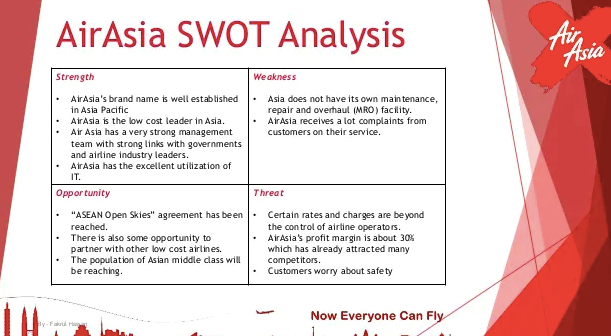Air Asia SWOT analysis – SWOT analysis of Air Asia: Air Asia is a low-cost airline with its headquarters in Malaysia. In Kuala Lumpur. The biggest airline in Malaysia the company is widely regarded as being highly focused on its employees. Compared to its competitors, Air Asia is credited with having the lowest cost operating at the cost per seat of US$0.023 per seat kilometer of available seats (ASK) and an average load factor for passengers of 52 percent.
Air Asia operates flights to approximately 165 destinations, which include domestic as well as international flights with that is 92. The airline operates four subsidiaries which include Air Asia X, Indonesia Air Asia X, Indonesia Air Asia, and Thai Air Asia.
The airline, which was put in 1993 began its operations in 1996. It is an extremely new airline. It has been awarded numerous times. Air Asia has been consecutively recognized as the most reputable low-cost airline across the Asian region. The company had annual revenue that was USD 1.12 billion in 2017. Currently, it employs approximately 17,000 workers.
Air Asia fun facts: AirAsia won Skytrax’s “World’s Best Low-Cost Airline” award for 8 years running.
About Air Asia – SWOT analysis of Air Asia
Contents
- 1 About Air Asia – SWOT analysis of Air Asia
- 2 Air Asia Competitors
- 3 SWOT analysis of Air Asia – Air Asia SWOT analysis
- 4 Strengths of Air Asia – Air Asia SWOT analysis
- 5 Weaknesses of Air Asia – SWOT Analysis Of Air Asia
- 6 Opportunities of Air Asia – Air Asia SWOT analysis
- 7 Threats of Air Asia – SWOT analysis of Air Asia
- 8 Overview Template of Air Asia SWOT analysis
- 9
[wp-svg-icons icon=”office” wrap=”I”] Company: The AirAsia Group
[wp-svg-icons icon=”user” wrap=”I”] CEO: Tony Fernandes
[wp-svg-icons icon=”user” wrap=”I”] Founder: Tony Fernandes | DRB-HICOM
[wp-svg-icons icon=”calendar” wrap=”I”] Year founded: 18 November 1996
[wp-svg-icons icon=”location-2″ wrap=”I”] Headquarters: Kuala Lumpur International Airport Sepang | Selangor | Malaysia
[wp-svg-icons icon=”stats” wrap=”I”] Annual Revenue: USD$1.12 Billion
[wp-svg-icons icon=”bars” wrap=”i”] Profit | Net income: USD$354 Million
[wp-svg-icons icon=”users” wrap=”I”] Number of employees: 20,000
[wp-svg-icons icon=”pie” wrap=”i”] Products & Services: Air transport, travel and lifestyle products | Financial services
[wp-svg-icons icon=”globe” wrap=”I”] Website: ir.airasia.com
Air Asia Competitors
[wp-svg-icons icon=”pacman” wrap=”I”] Competitors: Malaysian Airlines | JetStar Airways | Singapore Airlines | China Eastern Airlines | SpiceJet | China Southern Airlines | Shanghai Juneyao | SilkAir | Tiger Airways | Air Sahara | Air Deccan | Kingfisher | Air Arabia | Delta Airlines
SWOT analysis of Air Asia – Air Asia SWOT analysis
SWOT Analysis Of Air Asia is brand-based. SWOT Analysis of Air Asia evaluates the brand’s strengths, weaknesses, opportunities, and threats. Advantages and disadvantages can be attributed to internal factors while opportunities and threats can be attributed to external factors. We will be discussing Air Asia’s SWOT Analysis. Below is the detailed SWOT Analysis of Air Asia.
Let’s talk about Air Asia’s SWOT assessment.
Strengths of Air Asia – Air Asia SWOT analysis
- Stable and consistent placement: Air Asia has been promoted as a low-cost carrier. the airline has succeeded in ensuring that they maintain their operating costs as low as they can which means that the advantages of this flow into the cost.
- Weekly flights: Through consumer research, Air Asia realized that many customers would travel to and from Trichy to Chennai before continuing on to Kuala Lumpur, Singapore, and Bangkok which was turning out to be costly. Air Asia decided to start daily flights from Kuala Lumpur priced as low as 12000 rupees as a return fare, compared to the Rs 21,000 offered by other airlines.
- Wide coverage of India: Air Asia was quick to grasp the massive opportunity that India provided and therefore began to expand to the area. Air Asia operates approximately 120 routes to India connecting several key destinations and ensuring that economical travel options are available to its customers.
- Innovative thinking for service: Air Asia is employing cutting-edge technology for innovation. A few of their innovations in service include printing tickets online and even electronic check-in. The airline is also cutting costs by replacing the human element with technology by using online services.
- Effective cost-cutting: Air Asia has a very low-cost carrier and they have taken every feasible measure to cut expenses. One approach which has been adopted by Air Asia is to shift the responsibility of providing service to the consumer, resulting in the majority of the tasks being self-service.
Weaknesses of Air Asia – SWOT Analysis Of Air Asia
- Costs to sustain: Air Asia is a low-cost airline, and it is crucial that airlines maintain their operating costs at a minimum. With the fluctuation in fuel costs and the rise in costs for service and rising service costs, airlines face extreme difficulty keeping their expenses at a minimum.
- Low Profits: In order to maintain its status as an airline with low cost, Air Asia keeps their prices to be as cheap as is possible and consequently relies entirely on volume for its earnings which, in turn, has led to a decrease in profit margins as well as a reduction in constant revenue flows.
- Problems with finding a balance between the quality of services and price: The USP of Air Asia is the low-cost carrier image that it portrays. However, customers aren’t willing to sacrifice quality simply because they are priced at cheap prices and they are satisfied with the high quality of the services. Therefore, the airline finds it challenging to balance price and quality, and there is a claim that they compromise quality.
Opportunities of Air Asia – Air Asia SWOT analysis
- Increase in travel overseas: In Asia where Air Asia is headquartered, there’s been a rise in business travelers. Cities such as Singapore, Malaysia, and Bangkok are well-known on the world map of tourist destinations. the vacation season also has an increase in leisure travel. These are opportunities the airline could capitalize on.
Threats of Air Asia – SWOT analysis of Air Asia
- Competitors: The company faces lots of competition from other brands like Air India, Singapore Airlines, Virgin Airlines, etc.
- Cost management: Air Asia is finding it difficult to handle the fluctuations in the cost of fuel as well as to keep its large array of airplanes. The control of costs over time is the largest problem that the airline is facing.
You May Also Like:
- Singapore Airlines SWOT analysis
- Calvin Klein SWOT analysis – SWOT analysis of Calvin Klein
- Heineken SWOT analysis – SWOT analysis of Heineken
- United Parcel Service SWOT analysis
- Universal Parks SWOT analysis – SWOT analysis of Universal Parks
Overview Template of Air Asia SWOT analysis
This is the SWOT analysis of Air Asia. Please let us know if you have additional suggestions to add.
[wp-svg-icons icon=”bubbles” wrap=”i”] Let us know What do you think? Did you find the article interesting?
Write about your experiences and thoughts in the comments below.


